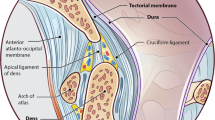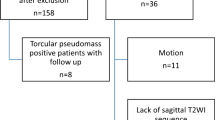Abstract
Our aim was to characterise and classify permanent structural changes in the tectorial and posterior atlanto-occipital membranes several years after a whiplash injury, and to evaluate the reliability of our classification. We obtained sagittal proton density-weighted images of the craniovertebral junction of 92 whiplash-injured and 30 uninjured individuals. Structural abnormalities in the two membranes were classified as grades 1–3 independently by three radiologists blinded for clinical information. Grading criteria were based on reduced tectorial membrane thickness, and elongation or rupture of the posterior atlanto-occipital membrane/dura mater complex. The same images were reassessed 4 months later. Image quality was graded good in 104 cases, slightly reduced in 13 and unsatisfactory in five. Of 117 tectorial membranes 31 (26.5%) showed grade 2 or 3 lesions, in the uninjured group none were grade 3 and only three were grade 2. Pair-wise interobserver agreement (weighted kappa) was moderate (0.47–0.50), while the intraobserver agreement was moderate to good (0.51–0.70). Of 117 posterior atlanto-occipital membranes 20 (17.1%) had grade 2 or 3 lesions; there was no grade 3 and only one grade 2 lesion in the uninjured group. Inter- and intraobserver agreement was good (0.61–0.74 and 0.65–0.86, respectively). Reduced image quality was the main reason for disagreement, but partial thinning and lateral tapering, as normal tectorial membrane variations, created difficulties in some cases. This study strongly indicates that whiplash trauma can damage the tectorial and posterior atlanto-occipital membranes; this can be shown on high-resolution MRI. Better knowledge of normal anatomical variations and improved image quality should increase the reliability of lesion classification.






Similar content being viewed by others
References
Dvorak J, Schneider E, Saldinger P, Rahm B (1988) Biomechanics of the craniocervical region: the alar and transverse ligaments. J Orthop Res 6: 452–461
Heller JG Amrani J, Hutton WC (1993) Transverse ligament failure; a biomechanical study. J Spinal Disord 6: 162–165
Saldinger P, Dvorak J, Rahn BA, Perren SM (1990) Histology of the alar and transverse ligaments. Spine 15: 257–261
Dickman CA, Mamourian A, Sonntag VK, Drayer BP (1991) Magnetic resonance imaging of the transverse atlantal ligament for the evaluation of atlantoaxial instability. J Neurosurg 75: 221–227
Soames RW (1995) Skeletal system. In: Gray H et al (eds) Gray's anatomy, 38th edn. Churchill Livingstone, New York, pp 425–736
Harris MB, Duvla MJ, Davis JA Jr, Bernine PM (1993) Anatomical and roentgenographic features of atlantooccipital instability. J Spinal Disord 6: 5–10
Krakenes J, Kaale BR, Rorvik J, Gilhus NE (2001) MRI assessment of normal ligamentous structures in the craniovertebral junction. Neuroradiology 43: 1089–1097
Krakenes J, Kaale BR, Moen G, Nordli H, Gilhus NE, Rorvik J (2002) MRI assessment of the alar ligaments in the late stage of whiplash injury – a study on structural abnormalities and observer agreement. Neuroradiology 44: 617–624 Erratum: Neuroradiology 44: 874–876
Spitzer WO, Skovron ML, Salmi LR, et al (1995) Scientific monograph of the Quebec Task Force on Whiplash-Associated Disorders: Redefining "whiplash" and its management. Spine 20: 1S–73S
Fleiss JL (1981) Statistical methods for rates and proportions, 2nd edn. Wiley, New York, pp 212–236
Altman DG (1997) Practical statistics for medical research. Chapman & Hall/CRC, London, pp 396–439
Altman DG (1997) Practical statistics for medical research. Chapman & Hall/CRC, London, pp 229–276
Brennan P, Silman A (1992) Statistical methods for assessing observer variability in clinical measures. Br Med J 304: 1491–1494
Grabb CB, Frye TA, Hedlund GL, Grabb PA, Royal SA (1999) MRI diagnosis of suspected atlanto-occipital dissociation in childhood. Pediatr Radiol 29: 275–281
Sun PP, Poffenbarger GJ, Durham S, Zimmerman RA (2000) Spectrum of occipitoatlantoaxial injury in young children. J Neurosurg 93 [Suppl 1]: 28–39
Adams VI (1993) Neck injuries: III. Ligamentous injuries of the craniocervical articulation without occipito-atlantal or atlanto-axial facet dislocation. A pathologic study of 21 traffic fatalities. J Forensic Sci 38: 1097–1104
Grauer JN, Panjabi MM, Cholewicki J, Nibu K, Dvorak J (1997) Whiplash produces an S-shaped curvature of the neck with hyperextension at lower levels. Spine 22: 2489–94
Grifka J, Hedtmann A, Pape HG, Witte H, Bar HF (1998) Biomechanics of injury of the cervical spine Orthopäde [German] 27: 802–812
Penning L (1998) Backward hypertranslation of the head: participation in the whiplash injury mechanism of the cervical spine? Orthopäde [German] 23: 268–274
Robinson PJ (1997) Radiology's Achilles' heel: error and variation in the interpretation of the Röntgen image. Br J Radiol 70: 1085–1098
Acknowledgements
We gratefully acknowledge Grethe Albrektsen PhD, Section of Medical Statistics, for statistical calculations and helpful suggestions; Leif Arve Abildgaard RT, Department of Radiology, for configuring the MRI sequences and Joost Gravendeel MD, Department of Radiology, for technical support with the illustrations.
Author information
Authors and Affiliations
Corresponding author
Rights and permissions
About this article
Cite this article
Krakenes, J., Kaale, B.R., Moen, G. et al. MRI of the tectorial and posterior atlanto-occipital membranes in the late stage of whiplash injury. Neuroradiology 45, 585–591 (2003). https://doi.org/10.1007/s00234-003-1036-7
Received:
Accepted:
Published:
Issue Date:
DOI: https://doi.org/10.1007/s00234-003-1036-7




